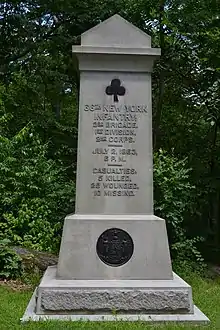| New York U.S. Volunteer Infantry Regiments 1861-1865 | ||||
|

The 66th New York Infantry Regiment (or National Guard Rifles) was an infantry regiment in the Union Army during the American Civil War.
Service
The 66th New York Infantry was organized at New York City,[3][4][5] [6] New York and mustered in for three years service on November 4, 1861, under the command of Colonel Joseph C. Pinckney.
The regiment was attached to Graham's Brigade, Buell's Division, Army of the Potomac, to January 1862. French's Brigade, Sumner's Division, Army of the Potomac, to March 1862. 3rd Brigade, 1st Division, II Corps, to March 1864. 4th Brigade, 1st Division, II Corps, to May 1865. Fort Richardson, New York, to August 1865.
The 66th New York Infantry mustered out of service August 30, 1865.[7]
Detailed service
The 66th, the "Governor's Guard," was the outgrowth of the 6th Militia, recruited mainly in New York City, and was mustered into the U. S. service at New York, November 4, 1861, for a three-year term. It left New York for Washington, November 16, 1861, was assigned to Graham's Brigade, Buell's Division, until January 1862, when it became a part of French's Brigade, Sumner's Division, which became in March, the 3rd Brigade, 1st Division, II Corps, Army of the Potomac. It reached the Peninsula in time to be present during the latter part of the siege of Yorktown; was active at Fair Oaks and during the Seven Days Battles, but suffered its most severe loss at Antietam,[8] where 103 were killed, wounded, or captured, among them Chaplain Dwight, who was in the midst of the fight. The 66th proceeded through Charlestown, West Virginia, and Snicker's Gap, to Fredericksburg, where it lost 75 in killed, wounded, and missing out of 238 engaged. It was then in the 3rd (Zook's) Brigade of Hancock's division, which also suffered severely at Chancellorsville, the loss of the 66th being 70 men. II Corps continued to see arduous service through the hard-fought field of Gettysburg[3] and the actions at Auburn and Bristoe Station, the last being a II Corps engagement. After the Mine Run movement the regiment went into winter quarters with the Army of the Potomac and when the spring campaign opened, was assigned to the 4th Brigade of its old division. In Grant's campaign in the Wilderness the heaviest losses of the 66th were suffered during the first week, but it continued in active service through Cold Harbor, where Col. Morris, commanding the brigade was killed, and the Siege of Petersburg, losing heavily in the first assault on the fortifications. In the autumn of 1864 the original members not reenlisted were mustered out and the reenlisted men and recruits remained at the front as a veteran organization. After the fall of Petersburg the regiment was ordered to Fort Richmond, New York Harbor, and there remained until August 30.[9]
Casualties
The regiment lost a total of 221 men during service; 9 officers and 88 enlisted men killed or mortally wounded, 4 officers and 120 enlisted men died of disease.[7]
Armament
The State of New York issued the 66th 774 imported .69* caliber Fusil d'Infanterie Mle 1842 rifle-muskets.[1][10] A year later, the regiment reported that they had turned in these arms and held 700 short Austrian rifled muskets.[11][12][lower-roman 2] As the service continued, the 1842 muskets were gradually replaced by imported French Fusil d'Infanterie Mle 1842 rifle muskets. By the end of the firt full year of hard campaigning, the regimented reported possession of 344 Enfield P1853s, 424 Mle 1842, and 62 Prussian Potsdam smoothbore percussion muskets (.71 caliber).[11][12]
Rifle-muskets
- Issued weapons
 French .69 Cal Model 1842
French .69 Cal Model 1842
Commanders
- Colonel Joseph C. Pinckney
- Colonel Orlando H. Morris - wounded in action at the Battle of Gettysburg, July 2; killed in action at the Battle of Cold Harbor while leading 4th Brigade, First Division, II Corps
- Colonel John S. Hammell - commanded at the Battle of Gettysburg as lieutenant colonel after Col Morris was wounded; also wounded on July 2
- Major Peter A. Nelson - commanded at the Battle of Gettysburg after Ltc Hammell was wounded
- Captain Julius Wehle - commanded at the Battle of Antietam
- Captain Nathaniel P. Lane - commanded at the First Battle of Deep Bottom
In popular culture
- In the 2017 film The Beguiled the film's protagonist, Corporal John McBurney (played by actor Colin Farrel) is a member of the 66th Regiment who finds refuge in a woman's boarding school in Virginia.
See also
Footnotes
- ↑ As reported back to Adjutant General Hillhouse upon departure from New York on November 16, 1861
- ↑ These were actually most likely M1854 Jäger rifle (Bavaria) which were frequently imported through Austrian exporters in the Adriatic. This percussion weapon combines French and German features with a browned barrel and a rear sight with windage adjustment. It is 50.25 inches (1,276 mm) long, with a .69 caliber 35.75-inch (908 mm) barrel. This is among the last military designs prior to adopting the Minie type ammunition
Citations
- 1 2 Hillhouse (1862), p. 15.
- ↑ Hillhouse (1862), p. 15; Hillhouse (1863), p. 1061.
- 1 2 66th New York Volunteer Infantry Regiment, Gettysburg (2018).
- ↑ Civil War in the East, 66th New York Volunteer.
- ↑ NYSMM, 66th Infantry Regiment (2019).
- ↑ CWA, 66th Regiment Infantry "Governor's Guard"(2016).
- 1 2 Dyer (1908), p. 1429.
- ↑ McPherson (1988), p. 541.
- ↑ Dyer (1908), p. 1429; Federal Publishing Company (1908), p. 99; Phisterer (1912), pp. 2648–2649.
- ↑ Delvolte, Fusil d'Infanterie Mle 1842, (2018).
- 1 2 Hillhouse (1863), p. 1061.
- 1 2 Mink, Armament in the Army of the Potomac, (2008), p.41.
References
- Dyer, Frederick Henry (1908). A Compendium of the War of the Rebellion (PDF). Des Moines, IA: Dyer Pub. Co. pp. 29, 43, 278, 289, 382, 1429. ASIN B01BUFJ76Q. Retrieved August 8, 2015.
 This article incorporates text from this source, which is in the public domain.
This article incorporates text from this source, which is in the public domain. - Federal Publishing Company (1908). Military Affairs and Regimental Histories of New York, Maryland, West Virginia, And Ohio (PDF). The Union Army: A History of Military Affairs in the Loyal States, 1861–65 – Records of the Regiments in the Union army – Cyclopedia of battles – Memoirs of Commanders and Soldiers. Vol. II. Madison, WI: Federal Publishing Company. p. 99. OCLC 1086145633.
 This article incorporates text from this source, which is in the public domain.
This article incorporates text from this source, which is in the public domain. - Hillhouse, Thomas (January 15, 1862). Adjutant General's Report, 1861 (PDF). Annual Reports of the Adjutant General of the State of New York. Albany, NY: New York (State). Adjutant General's Office. pp. 1–735. LCCN sn94095328. OCLC 1040003486. Retrieved 2020-04-10.
 This article incorporates text from this source, which is in the public domain.
This article incorporates text from this source, which is in the public domain. - Hillhouse, Thomas (January 27, 1863). Adjutant General's Report, 1862 (PDF). Annual Reports of the Adjutant General of the State of New York. Albany, NY: New York (State). Adjutant General's Office. pp. 1–735. LCCN sn94095328. OCLC 1039942785. Retrieved 2020-04-10.
 This article incorporates text from this source, which is in the public domain.
This article incorporates text from this source, which is in the public domain. - McPherson, James M. (1988). Battle Cry of Freedom: The Civil War Era (PDF). Oxford History of the United States (1st ed.). Oxford, UK: Oxford University Press. p. 904. ISBN 978-0-19-503863-7. OCLC 7577667.
- Mink, Eric J. (November 30, 2008). "Armament in the Army of the Potomac at Fredericksburg" (PDF). Mysteries & Conundrums. Fredericksburg & Spotsylvania NMP Staff. Retrieved November 14, 2020.
- Phisterer, Frederick (1912). Eighth Regiment of Infantry - Sixty-Ninth-Eighth Regiment of Infantry (PDF). New York in the War of Rebellion, 1861-1865. Vol. 3 (3rd ed.). Albany, NY: J. B. Lyon Company, State Printers. pp. 2648–2660. LCCN 14013311. OCLC 1359922. Retrieved 2023-04-06.
 This article incorporates text from this source, which is in the public domain.
This article incorporates text from this source, which is in the public domain. - "66th New York Volunteer Infantry Regiment". The Battle of Gettysburg. 2018. Retrieved 6 February 2019.
- "66th New York Volunteer Infantry Regiment, "Governor's Guard"". The Civil War in the East. 2016. Retrieved December 17, 2020.
- "64th Infantry Regiment: New York State Military Museum and Veterans Research Center". New York Division of Military and Naval Affairs. 2019. Retrieved 2020-04-08.
- "66th Regiment Infantry "Governor's Guard"". The Civil War Archives. American Civil War Archive. 2016. Retrieved 2017-04-08.
- Delvolte, Frederic. "armement reglementaire francais les fusils". armement reglementaire francais (in French). Retrieved 2023-04-16.
.svg.png.webp)
